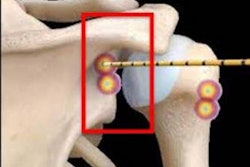
The permanent tattoos of patients represent an important potential safety hazard during MRI, and the shape of the tattoo is the major factor in increasing the radiofrequency (RF) heating effects, researchers are reporting at the International Society for Magnetic Resonance in Medicine virtual conference.
"Most of the cutaneous burns occur around the tattoos due to metallic pigments," explained Shahzeb Hayat, from the department of biomedical engineering at Hanyang University in Seoul, South Korea. Hayat presented the findings in a digital poster about the RF heating effects of various types of tattoos.
Hayat and colleagues used an ASTM-2002 phantom (from Zurich Med Tech, Switzerland), which is designed for evaluation of induced heating near passive medical implants and surroundings during MRI scans. The shape of the phantom is a strong simplification of the human torso and is filled with liquid or gel material approximating human tissue.
They filled the phantom with saline gel and then used a high-fidelity male 5-mm body mesh for all simulations and a high-pass birdcage coil as an RF source. For numerical analysis, 1.5-tesla and 3-tesla MRI setup were modeled by means of electromagnetic full-wave solvers (P-EM-FDTD, Sim4life) to compare the field distribution of tattoos with different types and positions on the body.
Six conditions were simulated to investigate the RF heating, and an experimental setup was created of a 3-tesla MRI scan on a patient with a Celtic tattoo. The Celtic tattoo was designed on a rubber pad and placed on the cylindrical phantom.
The maximum local specific absorption rate (SAR) was positively correlated with the tattoo shapes, according to Hayat and colleagues. They observed the hot spot of the tattoos on the long strips, sharp edges, and multiple adjacent points, and based on the types of tattoos analyzed, RF-induced heating depends on their shape.
Polydimethylsiloxane (PDMS) plays an effective role in the reduction of RF heating around tattoos. The tattoo is covered by PDMS to reduce the RF heating, the authors explained.
| Peak 10-g SAR due to the shape of tattoos | |||||||
| Tattoo design | Buttocks | Neck | With PDMS | ||||
| 64 MHz | 128 MHz | 300 MHz | 64 MHz | 128 MHz | 300 MHz | 64 MHz | |
| Circle | 2.31 | 4 | 8.4 | 3.43 | 6.4 | 9.6 | 1.91 |
| Alphabet M | 2.83 | 3.8 | 6.19 | 3.56 | 4.48 | 9.05 | 1.85 |
| Celtic | 3.78 | 5.68 | 10.6 | -- | -- | -- | 1.7 |
| Tribal | 2.98 | 4.35 | 9.7 | -- | -- | -- | 1.9 |
Swiss safety study
In a separate digital poster presented at ISMRM 2020, researchers from the Foundation for Research on Information Technologies in Society in Zurich investigated the impact of birdcage design on RF-induced risks during MRI. They did not look specifically at patients with tattoos.
The team led by Dr. Aiping Yao, head of MRI and implant safety, addressed the hypothesis that the exposure variation posed by the body coil of the installed MR system can be represented by a minimum set of generic birdcages covering the length of the current and future birdcages.
Their key findings were the following:
- Longer birdcage lengths result in larger SAR at normal operating mode, leading to lower B1 field strength at the SAR limits. The effect of birdcage bore-size is negligible.
- Sensitivity analysis of birdcage design (e.g., high-pass vs band-pass) and dorsal or lateral patient shift led to negligible variation compared to the dominant sources of patient anatomy, scan position, and birdcage polarization and size.
- Birdcages of different rung numbers show very similar in vivo-induced field distributions.


.fFmgij6Hin.png?auto=compress%2Cformat&fit=crop&h=100&q=70&w=100)





.fFmgij6Hin.png?auto=compress%2Cformat&fit=crop&h=167&q=70&w=250)











